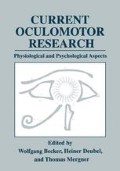Abstract
Studies of blinks have revealed the reciprocal relationship between the innervation patterns of the levator palpebrae superioris (LP) and the orbicularis oculi (00) muscles (Gordon 1951; Björk and Kugelberg 1953; Becker and Fuchs 1988; Evinger 1991; Aramideh et al. 1994a) resulting in a downward movement of the upper eyelid. Immediately prior to a blink, the discharge of the LP ceases whereas the 00 motoneurons produce a short high-frequency burst of activity. At the end of a blink the 00 actively turns off and the LP returns to its previous tonic activity either accompanied by an initial burst or not (Aramideh et al. 1994a). Concurrently the eye-globe makes a slight displacement of 1–2 millimeters back into the orbit (Evinger et al. 1984) and performs a horizontal, vertical (Collewijn et al. 1985; Riggs et al. 1987) and torsional rotation (Straumann et al. 1996). During blinks the rotation of the eye in straight-ahead position normally is directed nasally downward (Collewijn et al. 1985; Riggs et al. 1987). This rotation also depends on the initial eye position. Prolonged blinking or permanent closure of the eye may be accompanied by upward directed conjugate eye movements (Collewijn et al. 1985). To what extent the different extraocular muscles contribute to this combined translational and rotational movement is not yet known. Abnormalities of eye movements or eyelid movements or both have been reported in disorders of the basal ganglia and/or the midbrain. In essential blepharospasm occasionally eye movement disorders accompany the spasms of the eyelid closure (Aramideh et al. 1994b). This mutual interaction between some types of eye and eyelid movements may have a same origin.
Access this chapter
Tax calculation will be finalised at checkout
Purchases are for personal use only
Preview
Unable to display preview. Download preview PDF.
References
Aramideh M, Ongerboer de Visser BW, Devriese PP, Bour LJ and Speelman JD (1994a) Electromyographic features of levator palpebrae superioris and orbicularis oculi muscles in blepharospasm. Brain 117: 27–38.
Aramideh M, Bour LJ, Koelman JHTM, Speelman JD and Ongerboer de Visser BW (1994b) Abnormal eye movements in blepharospasm and involuntary levator palpebrae inhibition: clinical and pathophysiological considerations. Brain 117: 1457–1474.
Becker W, Fuchs AF (1988) Lid-eye coordination during vertical gaze changes in man and monkey. J Neurophysiology, 60: 1227–1252.
Björk A, Kugelberg E (1953) The electrical activity of the muscles of the eyes and eyelids in various positions and during movements. Electroencephalography and Clinical Neurophysiology 5: 595–602.
Bour LJ, Van Gisbergen JAM, Bruijns J and Ottes FP (1984) The double magnetic induction method for measuring eye movements — results in monkey and man. IEEE Trans Biomed Eng BME 31: 419–427.
Büttner-Ennever JA and Holstege G (1986) Anatomy of premotor centers in the reticular formation controlling oculomotor, skeletomotor and autonomic motor systems. Progress in Brain Research 64: 89–98.
Collewijn H, Van der Steen J and Steinman RM (1985) Human eye movements associated with blinks and prolonged eyelid closure. J Neurophysiol 54: 11–27.
Evinger C, Shaw MD, Peck CK, Manning KA and Baker K (1984) Blinking and associated eye movements in human, guinea pigs and rabbits. J Neurophysiol 52: 323–339.
Evinger C, Manning KA and Sibony PA (1991) Eyelid movements. Investigative Ophthalmology and Visual Science 32: 387–400.
Gordon G (1951) Observation upon the movements of the eyelids. British Journal of Ophthalmology 35: 339–351.
Ongerboer de Visser BW and Kuypers HGJM (1978) Late blink reflex changes in lateral medullary lesions. An electrophysiological and neuroanatomical study of Wallenberg’s syndrome. Brain 101: 285–294.
Riggs LA, Kelly JP, Manning KA and Moore RK (1987) Blink-related eye movements. Investigative Ophthalmology and Visual Sciences 28: 334–342.
Schmidtke K and Büttner-Ennever JA (1992) Nervous control of eyelid function. A review of clinical, experimental and pathological data. Brain 115: 227–247.
Straumann D, Zee DS, Solomon D and Kramer PD (1996) Validity of Listing’s law during fixations, saccades, smooth pursuit eye movements, and blinks. Exp Brain Res 112: 135–146.
Author information
Authors and Affiliations
Editor information
Editors and Affiliations
Rights and permissions
Copyright information
© 1999 Springer Science+Business Media New York
About this chapter
Cite this chapter
Bour, L.J., de Visser, B.W.O., Hettema, M., Swaneveld, A., Aramideh, M. (1999). Blinks and Associated Eye Movements. In: Becker, W., Deubel, H., Mergner, T. (eds) Current Oculomotor Research. Springer, Boston, MA. https://doi.org/10.1007/978-1-4757-3054-8_28
Download citation
DOI: https://doi.org/10.1007/978-1-4757-3054-8_28
Publisher Name: Springer, Boston, MA
Print ISBN: 978-1-4419-3308-9
Online ISBN: 978-1-4757-3054-8
eBook Packages: Springer Book Archive

